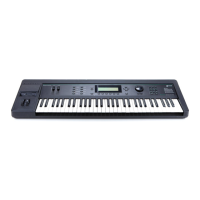Programming Examples
Example 1
19-1
Chapter 19
Programming Examples
The other chapters in this manual have described the K2vxÕs features in detail. This tutorial
chapter will take you step-by step through several programming operations.
Each of the following examples will begin from the same starting point: the default program
with ID 199. This program is included speciÞcally for the purpose of giving you a
programming template. Most of its parameters have been set at values that donÕt affect the
sound of the program.
You may want to adjust some of the parameters of Program 199, to create your own customized
programming template. Even if you donÕt, itÕs a good idea to begin with Program 199 when
youÕre building a new sound, so youÕll know exactly what you have from the start.
Example 1
Trumpet with Delayed Vibrato and Velocity-triggered Stabs
Vibrato is a regular oscillation in pitch that adds dimension to any sound. Brass players will
often ÒstabÓ a note, punching it then letting the pitch roll down smoothly or in small fast steps.
To create these effects, weÕll use an LFO to control the pitch, (this is the typical way to create
vibrato), and delay it with an ASR. This way youÕll hear the vibrato only on notes that you hold
for a second or so. The stab will be done with a second ASR controlling pitch and amplitude.
The stabÕs ASR will be triggered by a velocity trigger (VTRIG), so only those notes you play at
fortissimo will stab.
Start by selecting Program 199 and pressing EDIT. The ALG page will appear. The Þrst task is to
change the keymap. Press the KEYMAP soft button to select the KEYMAP page.
EditProg:KEYMAP||||||||||||<>Layer:1/1||
||||||||||||||||||||||||||||||||||||||||
KeyMap:
17|Trumpet|||||||||||
|Stereo:Off|
Xpose|:0ST||||||||TimbreShift|:0ST||||||
KeyTrk:100ct/key||AltSwitch|||:OFF||||||
VelTrk:0ct||||||||PlayBackMode:Normal|||
||||||
|
||||||
|
||||||
|
||||||
|
||||||
|
|||||
<more|
|
ALG|||
|
LAYER|
|
KEYMAP
|
PITCH|
|
more>
The KeyMap parameter is already selected, and as you can see, the Default program uses the
Grand Piano Keymap. Use any data entry method to change the Keymap to Trumpet, which
has ID 17. The KEYMAP page should look like the diagram above when youÕre done.
Remember that you can play your MIDI controllerÕs keyboard at any time while editing, so you
can listen to each change as you make it.
Next set up the vibrato. Start by selecting the PITCH page (press the PITCH soft button). Use
the cursor keys to move the cursor to the Src2 parameter. Use any data entry method to select
LFO1 as its value (pressing 1, 1, 4, ENTER on the alphanumeric pad is the quickest). This
assigns LFO1 to control the pitch of the trumpet sample.

